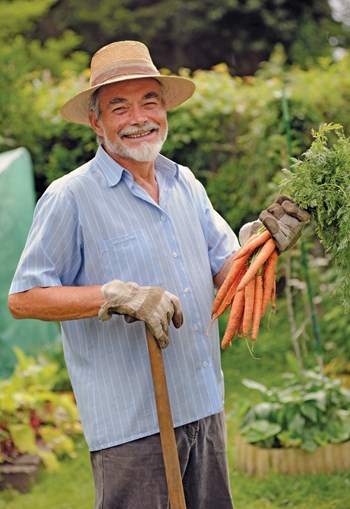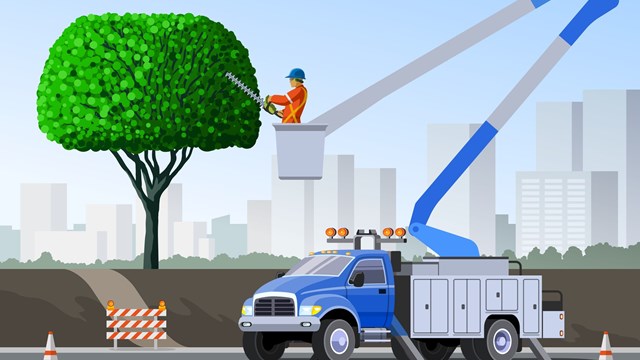
The “greening” of condominium living is expanding to the landscape, where shared fruit and vegetable gardens get residents involved and add beauty to the property. They’re not the Garden of Eden, but from small to large, they provide a bountiful harvest year-round for the resident homeowners.
Shared gardens appeal to today’s condo dwellers, often families seeking a more self-sustaining lifestyle – and a way to teach their children that broccoli doesn’t grow in plastic bags and fruit can be grown at home. Experts say real estate value rises in HOAs with shared gardens. Older condos, especially – with unused or run down green space – can benefit from this approach to property use. With so much interest, community architects are paying attention. And, for those just starting out, there’s a lot of technical assistance.
Updating “Victory Gardens”
John Norquist, president and CEO of the national Congress for the New Urbanism, compares this trend with a return to past eras, calling it “... a revival, in a way.” During World War II, he notes, there were Victory Gardens. “You even have a show in New England (The Victory Garden on PBS) based on them; there were vegetable gardens everywhere: on rooftops, in window boxes and yards. People even rented land along public rights of way. New urbanists like to retrieve old ideas, brush ‘em up and use them again. Now that people are starting to think of food production as an amenity, converting an old courtyard or parking lot to gardens makes land available (to them),” Norquist says.
“An older condominium, with a parking lot and some grass berms, is kind of boring, so anything that makes these more interesting is adding an amenity that younger people, in their 20s and 30s, are looking for.” A typical40-unit condominium in Boston’s Metrowest area, for instance, might well provide ample garden space, he says. “In a garden that may be 30 by 40 (feet), you can grow a lot of sweet corn, snap peas, onions and peppers.”
Russell Preston, a developer with Cornish Associates and board memberof the New England Chapter of the Congress for New Urbanism, works to change outdated zoning laws and development regulations impeding growth of urban gardening or other sustainable living methods. It’s not just business sense that interests his group; it’s the environment.
Retrofitting is very important for growth, he says. Families want access to home-grown, often organic, foods. The New England chapter is working to smooth the way for development that meets these stated needs and helpscurb suburban sprawl. This ideal includes both single condominium areas and mixed-use developments, as in Mashpee Commons in Mashpee, Massachusetts.
So how does one set up a communitygarden? It’s generally not expensive or difficult.
“It requires the developer or homeowners association to really take the initiative to set up a local garden club – someone to manage the space and develop some ‘neighborly’ pressure,” Preston said. “It essentially means carving out a piece of common area and giving it over to the residents to farm.”
An expanding community garden flourishes at Nubanusit Neighborhood and Farm in Peterborough, New Hampshire, a planned condominium community with 16 buildings (some houses are still available), designed as one- to four-bedroom residences. From the start, cofounders wanted Nubanusit, named after a brook on theproperty, to reflect sustainable living practices including heating and water use, conservation-minded lifestyles and biodynamic gardening.
Owner Participation is Key
Participation is key: during the three-quarter-acre garden’s three-year growth, residents have donated labor or purchased produce shares to support the effort, says James Heffron, a resident since March 2009 and an active gardener.
His recommendations:
• Start with raised beds while the ground is being enriched. This is especially true if the plot has beenpreviously used as industrial property.
• Develop roles for those who don’t work in the garden. Some residents prefer to wash, weigh and bundle the harvest.
• Post information frequently and use e-mails to round up workers. Busy residents prefer group gardening activities, achieving more in less time, and having a leader to oversee needed activities.
• Accept help. “We had a ‘Woofer’ for a month,” Heffron said. (A “woofer” is a volunteer from Worldwide Opportunities in Organic Farming, who works in exchange for room and board while traveling.)
• Consider a farm manager if the space is large; Nubanusit has one.
Nubanusit’s initial raised beds have graduated to a Community-Supported Agriculture (CSA) project providing enough produce to sell to local Peterborough customers. This summer, they hope to expand yields, selling moreoutside shares. Of course, Heffron adds, residents share in the risk: “If Mother Nature bombs the vegetables with hail, it’s everyone’s loss.”
Basically, he says, it’s a labor of love. “You’re not doing it because you’re getting paid so much in vegetables. There’s a widely shared feeling here that a lot of people would like to be producing their own share of food on the premises. Whole families come on planned work days. A lot of parents want constructive exposure to gardeningfor their children. Young ones like to weed and harvest, and the older boys like to take the hornworms off.”
“One thing that’s driving (success) … is that you have a lot of people who can step up and contribute,” Heffron said. Chores become odious if too few share in the work. “Sharing takes a little of the kind of relentless, tedious daily drudgery out of farming.”
Start Small
Bear three things in mind when building a community garden, says Nubanusit resident Johanna Wilson White: start small; plan according to theland, and build on individual talents.
• “It can be really overwhelming if you think, ‘We want to have a farm,’ instead of ‘We want to have a carrot patch.’ There’s a lot to learn in farming. As Americans, we’ve underestimated how much knowledge and experience and skill goes into farming.”
• Consider the land’s best use. “Kind of master-plan it,” she said. “Is there a part that gets a lot of wind and is cold, and better for something else? Is there a place where vegetables would do better? Get people thinking together about how to use the land.” Any master plan can be changed as time and experience lend wisdom to the idea, but a plan should exist.
• Respect that some folks won’t want to farm. “Build on what people’s talents are,” she said. “That’s where the CSA comes into play – with some people supporting the garden simply by purchasing a share of the produce, and others volunteering for non-field food responsibilities.”
Wilson White hopes to see production reach 35 bundles of produce weekly, each three to seven pounds, “depending on what’s ripe and what the weather does to the garden.”
As involvement and experience increase, labor declines. “At first, we asked volunteers to give five to 10 hours a week – that’s way, way, way too much for people who have other responsibilities. Now, we’ve turned it way down, to something like three hours. We’re not asking for the impossible, just figuring out what people can really do. And we’ve learnedto do more with less (people).”
They hired Todd Horner as part-time farm director. He keeps their labor aimed in the right direction at the right time, reducing waste and improving quality. The cost has been shared among residents and has proved worthwhile, she said.
She advises avoiding these pitfalls: setting expectations too high to start; not scheduling group gardening (whichmost prefer), and lack of knowledgeable leadership. In general, though, gardening is a learning experience. “People learn from our mistakes and move on,” she said.
Shared Goals
San Tunstall’s family lives at Mosaic Commons, one of two cohousing neighborhoods at Sawyer Hill EcoVillage in Berlin, Massachusetts. This is a young condominium community, whose residents share “green” goals and common spaces.
Being less than two years old, this community is still “home” to most of its founders, who are following through with their planning. Even the landscaping fits: the group planted blueberry bushes (already producing) and added fruit trees for the future. They’researching out a spot for raspberries, which tend to ramble too freely, Tunstall says. Blackberries edge the property; food and beauty, as dual benefits, were part of the plan. “We just thought that was a fabulous extra use of the land,” Tunstall said.
Meetings began the process, listing vegetables they wanted to grow and exploring roles.
Mosaic residents chose joint gardening– weeding, cultivating – to ease the load and introduce “newbies” to agriculture. Children, too, participate. While the first summer proved to be less “joint” and more “individual,” with some residents tending their own gardens instead of the selected group site, Tunstall hopes more will join in this year.
Daily watering schedules are a must.
Here also, not everyone works in the garden. Mosaic Commons’ qualityof life goals include sharing, regardless, Tunstall says. Their produce is given out, or left in the common areas for anyone to take.
“Everyone contributes in some way to the community’s benefit. We have a neighbor who cooks, but doesn’t want to garden. But we have shared meals a couple of times a week, and heuses the herbs in his cooking, which is fine with us. We’ve done a lot of those types of things – with a few people providing a benefit to a greater group.”
Tunstall’s advice for prospective farmers:
• Consider the soil’s condition, site location, access to water and sunshine.
• Start with raised beds if the soil is not ready. Some soil needs composting and enrichment first.
• Involve a team: Mosaic’s gardeners e-mailed seed choices, schedules, meeting times. They chose what todo about the soil while investing in raised beds for the interim.
• Use “starter” vegetables to begin with: peas, tomatoes, cucumbers, zucchini and the like.
• Even if weeding is sporadic, watering is critical. Tunstall says a different person is assigned watering daily.
• Schedule group work. “It’s more fun if you’re working alongside somebody,” says Tunstall.
• Don’t overestimate the first-year yields. Think small until soil improves and involvement expands.
• Pick when produce is ripe to avoid waste. “Next year, we’ll do a better job of alerting people when vegetables are ready by putting up notes to go pick some peas, or pick the zucchini before it gets too big.” (There are large common refrigerators for storage.)
“I know how much you can do witha little space,” Tunstall said. “There are specific techniques to improve yield, explained in the book “Square Foot Gardening” (see sidebar).
So far, Norquist can’t name any negatives or liabilities to condominium associations from the installation and operation of these gardens.
“If there’s a problem, it’ll be corrected,” he said. “And it’s not going to hurt the land. It’s a good idea to look at the context – if you’re halfway to Worcester from Boston, then one kindof garden might be more appropriate than in a more space-limited area, so you want to do it carefully.”
Planners can’t just “plop it anywhere, though. “Residents may have to adopt a vacant lot nearby, instead, or combine efforts with gardeners in nearby condoareas,” he said.
Even a lawsuit, say from someone who gets sick from produce, is unlikely. “My wife’s a lawyer, and she says the law does occasionally have common sense.”
Ann Connery Frantz is a freelance writer and a frequent contributor to New England Condominium magazine.






Leave a Comment